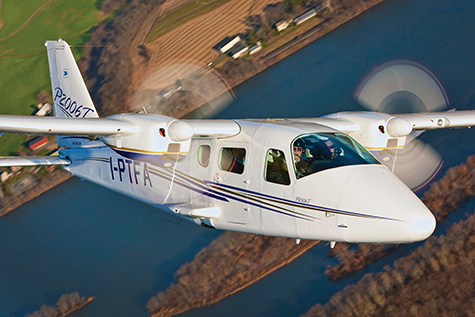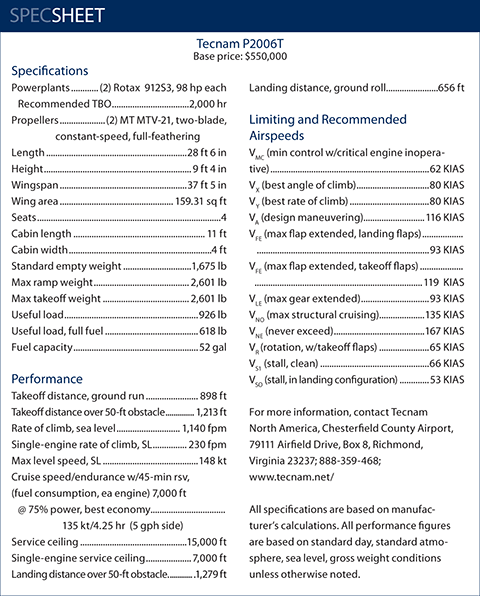Tecnam's Twin
Speed, style, and economy in an LSA-inspired package

Photography by Chris Rose
Want a fresh take on a light twin? Tecnam, manufacturer of the P92 Echo Super and P2002 Sierra light sport aircraft, has expanded its offerings by launching its new P2006T in the United States. The P2006T is a new slant on the traditional light twin idea, what with its four-cylinder, four-stroke, liquid-cooled 98-horsepower Rotax 912S3 engines, geared propellers and minimalist construction. Even so, it’s definitely not in the light sport aircraft (LSA) category. The airplane’s maximum takeoff weight and cruise speeds are far too high for LSA standards—and besides, it has two engines, four seats, and is IFR-capable. No, the P2006T is in a class of its own. Maybe we can call it an economy light, light twin. With “light” meaning a maximum gross takeoff weight of 2,601 pounds—that’s 1,200 pounds less than that of the Piper Seminole, and 1,335 pounds lighter than the Thielert-engined Diamond DA 42.
As of this writing (January 2010), some 20 P2006Ts were in European customers’ hands, and there were another 100 on order in North America. Federal Aviation Administration certification under FAR Part 23 was due within a couple weeks of the time we flew the P2006T, according to Tecnam’s Ben Young, who is the company’s North America’s vice president of business development and marketing.
Anyone who remembers the Italian-built Partenavia line of high-wing twins will immediately see a family resemblance in the P2006T. That’s because Partenavia designers conceived the P2006T and, similarly, today’s Vulcanair series of light twins also carry on the design themes established by Partenavia way back in the late 1950s.
Up and away
The P2006T may appear diminutive on the ramp, but it has a roomy interior, with large entry doors and comfortable simulated-leather seats. Once inside, you’re treated to a Garmin G1000 avionics package, a cluster of engine gauges over on the right side of the panel, a center console bearing generator and fuel pump switches, and a power quadrant with throttles, carburetor heat, and propeller control levers. The choke levers for starting the cold-running Rotaxes is beneath the quadrant, and an overhead panel has the start switches and fuel selectors. The Italian-registered demonstrator we flew, I-PTFA, has an S-TEC System Fifty-Five X autopilot and flight control system. Production models, we were told, will have G1000s with Garmin’s GFC700 flight control system.
The engine starts were uncomplicated, but then again the engines were still warm from a recent flight. Based on our experience with AOPA’s Rotax 912-powered Remos GX—our 2010 sweepstakes airplane—cold starts can demand extended idling before engine temperatures reach recommended values (120 degrees Fahrenheit) for takeoff. Not so on this day.
Turn on the fuel boost pumps, set the electrically actuated flaps to the “approach” deflection, add full power, accelerate to the rotation speed of 65 KIAS, lift off, climb away at VYSE (80 KIAS), and you’ll see a climb rate of approximately 1,140 fpm. Temperatures were well below standard the day we flew it, so I-PTFA showed 1,500 fpm. Not bad, since there were three aboard and the ship was very near maximum gross takeoff weight. Which brings up an appealing feature: a full-fuel payload of 600 pounds.
151 KTAS on 10 gph
At high-power settings the carbureted Rotaxes may be roaring away at up to 5,800 rpm, but reduction gearboxes convert this into propeller speeds as high as 2,200 rpm. For a max power speed check, we set power at 26 inches of manifold pressure and saw 151 KTAS. A 75-percent power setting of 25 inches of manifold pressure yielded a 142 KTAS cruise speed—a few knots faster than book. This, at 3,500 feet and a cool minus 8 degrees Celsius.
But the big news wasn’t so much the speed as the fuel consumption. Tecnam says that at maximum continuous power the P2006T burns five gph per side; at 75-percent, consumption drops to four gph per engine. Traditional light twins such as the Seminole have fuel burns twice that. Too bad we had to consult the performance tables for the fuel flow information; the P2006T isn’t equipped with fuel flow gauges.
The airplane showed off the stabilator and rudder’s sensitivity and light control forces—and the comparatively heavy ailerons. For just a small amount of stabilator and rudder control pressure, you get a lot for your effort. But the ailerons require a bit more muscle. In single engine work, that sensitive rudder takes some acclimation. On a positive note, it takes very little rudder pressure to counter the yaw into the dead engine. Those of us with experience in heavier twins may be tempted to revert to stomping too hard.
The airplane’s manners are quite good. Stalls and VMC demonstrations were straightforward with no surprises, although there was a pronounced wing drop during one power-off stall.
Fuel factors
The P2006T’s Rotaxes can burn either 92 octane auto gas or 100LL. Burning auto gas promises huge fuel savings, but accessibility can be a problem. Opting for 100LL is a lot more convenient—and expensive—but entails maintenance penalties. The engines don’t scavenge lead very well, so to rid them of lead accumulations you must perform oil changes at 25-hour intervals. The oil reservoir (which holds three quarts of motorcycle oil) has to be removed and flushed every 200 hours, and the propellers’ gearbox clutches must be inspected every 600 hours; burn mogas, and this interval is 800 hours. It will be interesting to see how actual maintenance costs add up once the P2006T fleet gets more time in service. Engine TBO is set at 2,000 hours.
If the airplane has a handling fault, it’s the low, 91-knot gear-extension speed. The airplane’s slippery, so when entering the traffic pattern you have to put on the brakes by pulling the power to 15 inches of manifold pressure, then wait for it to slow before dropping the electro-hydraulically actuated landing gear—which take 20 seconds to extend. Reaching 85 knots, the drill is to lower the electrically actuated flaps to the first, “approach” deflection, then bump up the power to 20 inches to maintain altitude on the downwind and base legs. For instrument approaches, Tecnam’s vice president of Flight Training Services, Dave Lubore, says to fly to a point two miles before the final approach fix, then slow to 85 knots, lower the gear and approach flaps, and drive down the final approach course at 85 knots. In visual flight rules, Lubore recommends flying down final at 70 knots with full flaps, 75 knots with approach flaps, and 82 knots with flaps fully retracted.
Tecnam says the P2006T could fill a number of market niches. Most obvious is the multi-trainer market, but the company also thinks the airplane could serve as a nice rental airplane, appeal to those stepping down from older and larger piston twins, or those stepping up from complex piston singles who want that second engine. Final pricing has yet to be determined, but Tecnam says that $550,000 is the current estimate for a G1000-equipped P2006T; steam-gauge models should run about $410,000. Those are hefty prices, but they’re lower than the price tags for a DA42 or a Seminole. This, coupled with the low fuel burn, excellent endurance, good payload, and the promise of lower operating costs, gives the airplane a fighting chance in today’s light twin marketplace.
E-mail the author at [email protected].



